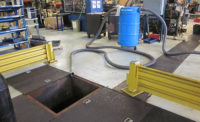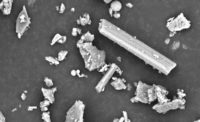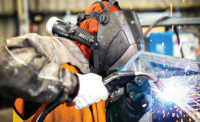Although we talk about a company’s bottom line as the reason to implement engineering controls to reduce or eliminate respiratory hazards in the workplace, that doesn’t mean most organizations put profit above worker safety. In fact, plant managers and safety professionals working within an industrial environment have a vested interest in protecting their own health alongside their co-workers. Quantifying the benefits of reducing or eliminating hazards when implementing engineering controls help organizations weigh which technologies provide the highest safety controls in the most cost-effective manner.
OSHA’s respiratory standard 1910.134 (a)(1) states the primary objective to control respiratory disease is to “prevent atmospheric contamination” of harmful dusts. Only “when effective engineering controls are not feasible,” are respirators mandated as the control.
Harmful dust
Manual materials handling and housekeeping are two of the greatest contributors to harmful respirable dust throughout most industries.
Most regulating bodies including OSHA and NFPA advocate the use of vacuum technology, such as industrial vacuum cleaning systems or vacuum conveying systems, for preventing harmful dusts from entering the environment.
To help employers recognize the value in prevention, OSHA’s $afety Pays worksheet calculates costs associated with specific injuries and includes a dollar amount of additional sales (and increased production) needed to cover those costs. The same webpage also includes links to sites that calculate the ROI on health and safety expenditures.
According to the worksheet, direct costs for a single respiratory injury are estimated to be $24,577, with indirect costs just above that amount at $27,034. Using a default profit margin of 3 percent, the amount of increased sales needed to recoup the combined $56,111 of direct and indirect costs are estimated to be $1,720,366.
More serious respiratory injuries, listed under “dust disease” and including silicosis, asbestosis and black lung disease, have slightly higher combined direct and indirect costs of $65,532. Recent reporting of silicosis injury, and subsequent settlements in the millions, demonstrate how important it is for a company to engineer hazards out of the working environment as OSHA's respiratory standard suggests.
Although silica exposure has dominated headlines, there are many other dusts that can cause serious lung disease including food flavorings, industrial dyes, metal powders and even vegetable dust.
Fugitive dust and debris is a housekeeping issue that plagues most industries. Heavy-duty industrial vacuum cleaners are designed to meet the needs of a wide range of industries and applications.
Cleaning options
Most industrial vacuum cleaning solutions employed to combat dust aren’t considered capital expenditures. Often pre-engineered vacuum packages, equipped for specific industry applications and powder characteristics, can be purchased as plug-and-play units, far below indirect costs incurred from a single respiratory illness.
Some options available in industrial vacuum cleaners include air-powered units, electric powered (including intrinsically safe options), continuous duty, portable, stationary central vacuums and even portable vacuums that operate like a central vacuum cleaning system.
There are industrial vacuums equipped with 55-gallon drums, continuous bagging options, and even 2-yard discharge hoppers, with standard PTFE high efficiency filter, rated 99.9 percent efficient at 1 micron. When dealing with pharmaceutical powders, silica, lead, asbestos, beryllium and hexavalent chrome, a HEPA secondary filter cartridge, rated 99.97 percent efficient at 0.3 micron is utilized.
For high-density materials, such as steel shot, grit, cement, foundry sand and other similar materials, break-away central vacuum systems can move up to 10,000 lbs (4,500 kg) per hour of materials such as Portland cement from distances up to 30 feet away. Break-away central vacuum systems lie somewhere between portable industrial vacuums and powerful central vacuum systems.
Material handling
Manual material handling of powders and bulk solids is the greatest contributor of worker exposure to respiratory hazards, as well as being the top contributor of ergonomic injury.
When powders and bulk solids are dumped from one container into another, dust clouds enter the environment exposing workers to harmful dusts, which is why many organizations are implementing vacuum conveyors as engineering controls to eliminate hazards.
Standard conveying systems consists of five basic pieces of equipment that come together to work as one – a pick up point, convey tubing, a vacuum receiver, a vacuum producer and a control module.
Like industrial vacuum cleaners, pre-engineered conveying systems offer processors and manufacturers turnkey systems to eliminate dust released into the environment.
Most regulatory agencies recognize vacuum technologies, such as industrial vacuum cleaners and vacuum conveying systems, as accepted engineering controls to prevent employee exposure to contaminants that can cause respiratory diseases such as silicosis, occupational asthma and COPD.



